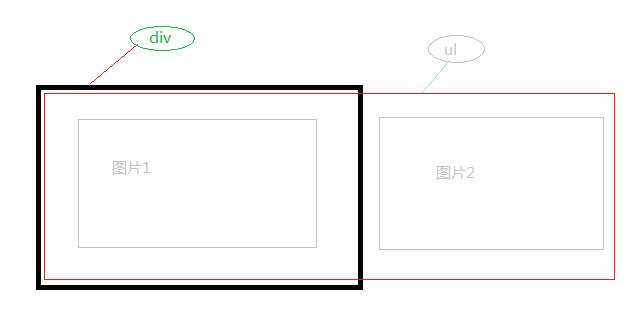Teach you step by step how to implement a carousel using jQyery
Implementation Principle
As shown in the figure, imagine if the width attribute value of
- is set very wide until all your pictures can be accommodated, and each picture uses
Then when we move ul to the left and the distance moved is the width of
- , the second
- will be moved to the window of , so that the picture Wasn’t it just displayed one by one?
Next we set the overflow:hidden attribute of
, then the pictures outside thewindow will not be displayed, and only the pictures moved to the current window will be displayed. Isn’t it more perfect? It feels like It's almost ready, right?
# After talking about some principles, okay, let’s go directly to the code, remember to introduce jquery.
This is the layout made by div. Remember to add a border when making it and delete it after making it. This will make it easier to test.
<div class="slideShow"> <div class="nav-t"> <ul> <li><a href="#" target="_blank"><img src="/static/imghw/default1.png" data-src="images/1.png" class="lazy" alt=""></a></li> <li><a href="#" target="_blank"><img src="/static/imghw/default1.png" data-src="images/2.png" class="lazy" alt=""></a></li> <li><a href="#" target="_blank"><img src="/static/imghw/default1.png" data-src="images/3.png" class="lazy" alt=""></a></li> <li><a href="#" target="_blank"><img src="/static/imghw/default1.png" data-src="images/4.png" class="lazy" alt=""></a></li> <li><a href="#" target="_blank"><img src="/static/imghw/default1.png" data-src="images/5.png" class="lazy" alt=""></a></li> </ul> <div class="nav-b"> <span class="active">1</span> <span>2</span> <span>3</span> <span>4</span> <span>5</span> </div> </div> </div> <script type="text/javascript" src="jquery-min.js"></script> <script type="text/javascript" src="lunbo.js"></script>
Copy after loginNext set the style
<style> .slideShow{ border:0px solid blue; width:600px; height:450px; margin:50px auto; position:relative; } .nav-t{ border:0px solid red; width:580px; height:430px; margin:8px auto; position:relative; overflow:hidden; } .nav-t ul{ border:0px solid green; list-style:none; width:3000px; height:430px; margin:0; padding:0; position:relative; } .nav-t li{ height:427px; width:580px; float:left; } .nav-b{ position:absolute; top:390px; left:220px; cursor:default; } .nav-b span{ margin-right:5px; border:1px solid red; padding:0 6px; border-radius:12px; color:#fff; background:rgba(132,125,119,0.5); cursor:pointer; } .nav-b span.active{ background:rgba(0,0,0,0.8); } </style>Copy after loginUse js implements click carousel pictures, automatic carousel pictures, and moves the mouse up to stop the carousel
$(function(){ $(function(){ var slide=$(".slideShow"), navt=slide.find(".nav-t"), ul=navt.find("ul"), navbs=slide.find(".nav-b span"), onwidth=ul.find("li").eq(0).width(), //获取ul下的li宽度 timer=null, inow=0; navt.hover(function(){ clearInterval(timer); //鼠标移上去,清除掉自动轮播功能,即定时轮播 },autoPlay); navbs.on("click",function(){ //点击轮播事件 var me=$(this); inow=me.index(); //此处变量用的与自动轮播函数里的相同,为的是能在随便点击后,自动轮播时按照我们点击了的继续向后轮播,这叫动态实时 ul.animate({left:-inow*onwidth},0.01); //ul向左移动从而使得下一个li显示到div的当前窗口 navbs.removeClass("active"); //清除掉上一个点击按钮的样式 me.addClass("active"); //为当前被点击的按钮添加第一个按钮样式 }); autoPlay(); function autoPlay(){ //自动轮播函数 timer=setInterval(function(){ //开定时器 inow++; if(inow==navbs.length){ //判断是否到了最后一张,若是到了,返回到第一张 inow=0 } navbs.eq(inow).trigger("click"); //根据定时的时间用span的索引自动调用click事件,trigger为jQuery的自动调用函数 },3000); } }); });Copy after loginLet’s take a look at the rendering? Okay

##SummaryOkay, the above is the entire content of using jQyery to implement the carousel. How? Like, how about you make one too? I hope that the content of this article will be of some help to everyone's study or work. If you have any questions, you can leave a message to communicate. For more related articles that teach you step by step how to implement a carousel using jQyery, please pay attention to the PHP Chinese website!

Hot AI Tools

Undresser.AI Undress
AI-powered app for creating realistic nude photos

AI Clothes Remover
Online AI tool for removing clothes from photos.

Undress AI Tool
Undress images for free

Clothoff.io
AI clothes remover

Video Face Swap
Swap faces in any video effortlessly with our completely free AI face swap tool!

Hot Article

Hot Tools

Notepad++7.3.1
Easy-to-use and free code editor

SublimeText3 Chinese version
Chinese version, very easy to use

Zend Studio 13.0.1
Powerful PHP integrated development environment

Dreamweaver CS6
Visual web development tools

SublimeText3 Mac version
God-level code editing software (SublimeText3)

Hot Topics
 1656
1656
 14
14
 1415
1415
 52
52
 1309
1309
 25
25
 1257
1257
 29
29
 1229
1229
 24
24
 Demystifying JavaScript: What It Does and Why It Matters
Apr 09, 2025 am 12:07 AM
Demystifying JavaScript: What It Does and Why It Matters
Apr 09, 2025 am 12:07 AM
JavaScript is the cornerstone of modern web development, and its main functions include event-driven programming, dynamic content generation and asynchronous programming. 1) Event-driven programming allows web pages to change dynamically according to user operations. 2) Dynamic content generation allows page content to be adjusted according to conditions. 3) Asynchronous programming ensures that the user interface is not blocked. JavaScript is widely used in web interaction, single-page application and server-side development, greatly improving the flexibility of user experience and cross-platform development.
 The Evolution of JavaScript: Current Trends and Future Prospects
Apr 10, 2025 am 09:33 AM
The Evolution of JavaScript: Current Trends and Future Prospects
Apr 10, 2025 am 09:33 AM
The latest trends in JavaScript include the rise of TypeScript, the popularity of modern frameworks and libraries, and the application of WebAssembly. Future prospects cover more powerful type systems, the development of server-side JavaScript, the expansion of artificial intelligence and machine learning, and the potential of IoT and edge computing.
 JavaScript Engines: Comparing Implementations
Apr 13, 2025 am 12:05 AM
JavaScript Engines: Comparing Implementations
Apr 13, 2025 am 12:05 AM
Different JavaScript engines have different effects when parsing and executing JavaScript code, because the implementation principles and optimization strategies of each engine differ. 1. Lexical analysis: convert source code into lexical unit. 2. Grammar analysis: Generate an abstract syntax tree. 3. Optimization and compilation: Generate machine code through the JIT compiler. 4. Execute: Run the machine code. V8 engine optimizes through instant compilation and hidden class, SpiderMonkey uses a type inference system, resulting in different performance performance on the same code.
 JavaScript: Exploring the Versatility of a Web Language
Apr 11, 2025 am 12:01 AM
JavaScript: Exploring the Versatility of a Web Language
Apr 11, 2025 am 12:01 AM
JavaScript is the core language of modern web development and is widely used for its diversity and flexibility. 1) Front-end development: build dynamic web pages and single-page applications through DOM operations and modern frameworks (such as React, Vue.js, Angular). 2) Server-side development: Node.js uses a non-blocking I/O model to handle high concurrency and real-time applications. 3) Mobile and desktop application development: cross-platform development is realized through ReactNative and Electron to improve development efficiency.
 Python vs. JavaScript: The Learning Curve and Ease of Use
Apr 16, 2025 am 12:12 AM
Python vs. JavaScript: The Learning Curve and Ease of Use
Apr 16, 2025 am 12:12 AM
Python is more suitable for beginners, with a smooth learning curve and concise syntax; JavaScript is suitable for front-end development, with a steep learning curve and flexible syntax. 1. Python syntax is intuitive and suitable for data science and back-end development. 2. JavaScript is flexible and widely used in front-end and server-side programming.
 How to Build a Multi-Tenant SaaS Application with Next.js (Frontend Integration)
Apr 11, 2025 am 08:22 AM
How to Build a Multi-Tenant SaaS Application with Next.js (Frontend Integration)
Apr 11, 2025 am 08:22 AM
This article demonstrates frontend integration with a backend secured by Permit, building a functional EdTech SaaS application using Next.js. The frontend fetches user permissions to control UI visibility and ensures API requests adhere to role-base
 From C/C to JavaScript: How It All Works
Apr 14, 2025 am 12:05 AM
From C/C to JavaScript: How It All Works
Apr 14, 2025 am 12:05 AM
The shift from C/C to JavaScript requires adapting to dynamic typing, garbage collection and asynchronous programming. 1) C/C is a statically typed language that requires manual memory management, while JavaScript is dynamically typed and garbage collection is automatically processed. 2) C/C needs to be compiled into machine code, while JavaScript is an interpreted language. 3) JavaScript introduces concepts such as closures, prototype chains and Promise, which enhances flexibility and asynchronous programming capabilities.
 How do I install JavaScript?
Apr 05, 2025 am 12:16 AM
How do I install JavaScript?
Apr 05, 2025 am 12:16 AM
JavaScript does not require installation because it is already built into modern browsers. You just need a text editor and a browser to get started. 1) In the browser environment, run it by embedding the HTML file through tags. 2) In the Node.js environment, after downloading and installing Node.js, run the JavaScript file through the command line.







